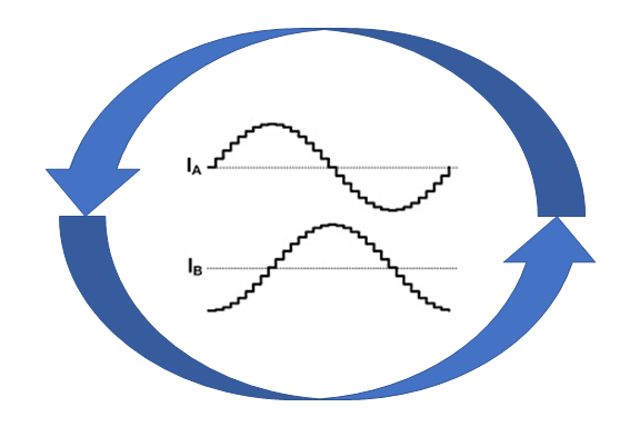Closed-Loop Control of Stepper Motors Webinar
Stepper motors are employed in a variety of applications across the engineering spectrum because they are inexpensive, simple to operate, and offer high torque at low speeds.
However, stepper motors suffer from drawbacks such as missed steps, decreased torque at high speeds, resonances, and high power consumption.
In this webinar, three methods will be introduced that can be used to mitigate these issues by closing the loop around a stepper motor:- End-Point Correction
- Stepper Position Maintenance Mode
- Closed-Loop Microstepping
- Controlling a Stepper Motor as a Brushless Motor
Presenter: Kushal Patel

[Webinar] Closed-Loop Control of Stepper Motors

Stepper motors are employed in a variety of applications across the engineering spectrum because they are inexpensive, simple to operate, and offer high torque at low speeds. However, stepper motors suffer from drawbacks such as missed steps, decreased torque at high speeds, resonances, and high power consumption. In this webinar, three methods will be introduced that can be used to mitigate these issues by closing the loop around a stepper motor:
1. End-Point Correction
2. Stepper Position Maintenance Mode
3. Closed-loop Microstepping
4. Controlling a Stepper Motor as a Brushless MotorJoin us for this free, live webinar on Tuesday, July 18th at 11AM PST
Using Raspberry Pi to Create Powerful, Low Cost Solutions with Galil Controllers
With the recent advancements in single board PCs, having a powerful computing device is now easier and more cost-effective than ever. The Raspberry Pi Foundation and its Raspberry Pi model, in particular, have set the stage for this new form of computer. This low-cost platform invites the question,” what is its role in the automation industry?” In this webinar, we will discuss where the Raspberry Pi fits in and how it can be used with Galil’s high-performance controllers and PLCs.
The following is what will be discussed:
- An overview of the motion control and software systems.
- How to get started with Raspberry Pi.
- Example Applications using the Raspberry Pi with Galil Motion Controllers and PLCs.
- Data logging
- Single axis motion control with a touchscreen
- More complex automation machine
Presenter: Troy Miller

Control Schemes for Dealing with Nonlinear Mechanics Webinar
There are many challenges when designing a motion control system. One challenge that can overwhelm many engineers is nonlinear mechanics. These mechanics can make tuning a motion control system difficult. At Galil, we pride ourselves in being able to provide intuitive solutions for these nonlinear or unorthodox mechanics. This webinar will discuss six examples of applications with nonlinear mechanics, their inherent challenges, and the tools/solutions to address these challenges.
Below are the six examples of applications with nonlinear mechanics:
-
High-friction axis
-
Mechanics with backlash
-
Servo axis involving a spring
-
Axis exposed to large and unpredictable outside forces
-
Mechanics where inertia varies with position
-
Hydraulic axis
Title: Control Schemes for Dealing with Nonlinear Mechanics
Presenter: Robin Riley
-
Ethernet or EtherCAT for Motion Control Webinar: Choosing the Right Network for Your Applications
With the increasing presence of EtherCAT in the motion control industry, choosing between EtherCAT and Ethernet is becoming an increasingly important question. This presentation will cover the technical differences between both methods and provide advice on how to choose between them based on application requirements. Strengths and weakness of both Ethernet and EtherCAT will be discussed including development time, ease of use, cost, and complexity.
Additionally, Galil’s DMC-500x0 EtherCAT Master and DMC-40x0 Ethernet controller will be reviewed with regards to the capabilities and advantages they can offer. This presentation is geared towards system developers looking to understand the differences, costs, and capabilities of both Ethernet and EtherCAT.
Title: EtherCAT or EtherCAT for Motion Control Webinar: Choosing the Right Network for Your Applications
Presenter: Matt Klint, Galil Motion ControlEtherCAT as a Master Machine Control Tool Webinar
Download Webinar in WMV Format
There is an increasing demand in the automation and motion control industries for a localized motion control solution that can coordinate motion between multiple remote components. Previously, field bus protocols such as Modbus or Ethernet/IP have been implemented to address this demand. Although successful in moving data across automation networks, these protocols lacked the real time performance necessary for a distributed motion control system.
The EtherCAT communication protocol provides a high speed, low overhead communication scheme that allows efficient, deterministic communication between motion controller and remote components. Based on Ethernet and streamlined specifically for point to point transmission of real time data, the EtherCAT standard is quickly becoming the preferred choice for centralized control of tightly coupled motion between remote components. This presentation is aimed at designers of automation and motion control systems with a basic understanding of Ethernet communication.
Title: EtherCAT as a Master Machine Control Tool Webinar
Presenters: Matt Klint, Galil Motion Control.Listen to the live recording of 'The Evolution of Ethernet in Control Systems'
Listen to the live recording of 'The Evolution of Ethernet in Control Systems'
This webinar presents the evolution of Ethernet in motion control systems and why Ethernet is the protocol of choice for industrial and automation applications. In this presentation we discuss the differences of Ethernet in a distributed vs centralized architecture and the trade off in performance. The discussion includes a description of popular deterministic and non-deterministic Ethernet communication protocols and what control applications they best suit.
Title:The Evolution of Ethernet in Motion Control
Presenters: Ann Keffer and Robin Riley, Galil Motion ControlLink to recording: https://www1.gotomeeting.com/register/730868336


